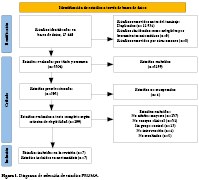Efectos del ejercicio aeróbico sobre los componentes del síndrome metabólico en adultos mayores con diabetes mellitus tipo 2: revisión sistemática y metaanálisis
DOI:
https://doi.org/10.17843/rpmesp.2024.412.12751Palabras clave:
Ejercicio Físico, Diabetes Mellitus, Anciano, Revisión Sistemática, Síndrome MetabólicoResumen
Objetivo. Determinar los efectos del ejercicio aeróbico sobre los componentes del síndrome metabólico en pacientes adultos mayores diabéticos mediante una revisión sistemática con meta-análisis. Materiales y métodos. Utilizamos las bases de datos PubMed/Medline, Scopus, Cochrane library, Web of Science y el buscador Google Scholar. Se seleccionaron los ensayos controlados aleatorizados (ECA) según los criterios de inclusión. Dos revisores determinaron de forma independiente si los estudios cumplían con los criterios de inclusión, extrajeron los datos y utilizaron la herramienta Cochrane de riesgo de sesgo (RoB 2). Los
análisis cuantitativos se realizaron en el programa R v 4.0.5, utilizando efectos aleatorios. Resultados. Las búsquedas identificaron 8697 estudios, de los que siete ECA se incluyeron en la síntesis cualitativa. Se evaluó que la mayoría de los estudios tenían un RoB alto o bajo en al menos tres dominios. El metaanálisis mostró que el ejercicio aeróbico fue eficaz para mejorar los niveles
de glucosa (diferencia de medias estandarizada [DME]: -1,04; intervalo de confianza al 95% [IC 95%] -1,27; -0,81), presión arterial sistólica (DME: -0,79; IC 95%: -1,02; -0,56), presión arterial diastólica (DME: -0,75; IC 95%: -0,98; -0,52), hemoglobina glucosilada (DME: -0,57; IC 95%: -0,77; -0,37), HDL (DME: 0,35; IC 95%: 0,15; 0,55), triglicéridos (DME: -0,26; IC 95%: -0,47; -0,06). No se informaron efectos adversos significativos. El nivel de certeza de los resultados fue baja para la glucosa en ayunas, moderado para la presión arterial sistólica y diastólica, y muy bajo para los demás resultados, además de pocos efectos adversos. Sin embargo, estos resultados deben ser interpretados con cautela debido al uso de marcadores subrogados. Conclusiones. El
ejercicio aeróbico demostró tener una mejoría significativa en los componentes del síndrome metabólico en adultos mayores diabéticos y no se reportaron efectos adversos importantes. Sin embargo, recomendamos más ECA que tengan un mayor tiempo
de intervención para establecer el impacto sobre los síntomas y las complicaciones.
Descargas
Referencias
United Nations. Department of Economic and Social Affairs Population. World Population Ageing 2019. [Fecha de acceso: 02 de octubre de 2022]. Disponible en: https://www.un.org/en/development/desa/population/publications/pdf/ageing/WorldPopulationAgeing2019-Report.pdf.
International Diabetes Federation. IDF Diabetes Atlas, 9th edn. Brussels, Belgium [Internet]. Atlas de la Diabetes de la FID. 2019. [Fecha de acceso: 11 de abril de 2024]. Disponible en: https://www.diabetesatlas.org/upload/resources/material/20200302_133352_2406-IDF-ATLAS-SPAN-BOOK.pdf.
Centers for Disease Control and Prevention and The Merck Company Foundation. The State of Aging and Health in America 2013. US Dept of Health and Human Services. 2013; [Fecha de acceso 11 de abril de 2024]. Disponible en: https://www.cdc.gov/aging/pdf/state-aging-health-in-america-2013.pdf.
Zhang B, Zhang B, Zhou Z, Guo Y, Wang D. The value of glycosylated hemoglobin in the diagnosis of diabetic retinopathy: a systematic
review and Meta-analysis. BMC Endocr Disord. 2021 Dec 1;21(1). doi: 10.1186/s12902-021-00737-2.
Henrietta G, János S, Zoltán B. Glycated hemoglobin as an option in screening for metabolic syndrome. AKJjournals 2021 Aug
;62(31):1244–51. doi: 10.1556/650.2021.32125.
Cavero-Redondo I, Martínez-Vizcaíno V, Álvarez-Bueno C, Agudo-Conde C, Lugones-Sánchez C, García-Ortiz L. Metabolic syndrome
including glycated hemoglobin a1c in adults: Is it time to change? J Clin Med. 2019 Dec 1;8(12). doi: 10.3390/jcm8122090.
Kanter JE, Bornfeldt KE. Impact of Diabetes Mellitus. Arterioscler Thromb Vasc Biol. 2016;36(6):1049–53. doi: 10.1161/ATVBAHA.116.307302.
Cardiovascular disease and risk management: Standards of medical care in diabetes- 2020. Diabetes Care. 2020;43(1):S111–34. doi:
2337/dc20-S010.
American Diabetes Association. Older Adults : Standards of Medical Care in Diabetes. Diabetes Care. 2020;43(1):152–62. doi: 10.2337/dc20-S012.
Aschner P. IDF Clinical Practice Recommendations for managing Type 2 Diabetes in Primary Care. Diabetes Res Clin Pract.
;132:169–170. doi: 10.1016/j.diabres.2017.09.002.
Tonoli C, Heyman E, Roelands B, Buyse L, Cheung SS, Berthoin S, et al. Effects of different types of acute and chronic (training) exercise on glycaemic control in type 1 diabetes mellitus: A meta-analysis. Sports Medicine. 2012;42(12):1059–80. doi: 10.1007/BF03262312.
Gordon BA, Benson AC, Bird SR, Fraser SF. Resistance training improves metabolic health in type 2 diabetes: A systematic review. Diabetes Res Clin Pract. 2009;83(2):157–75. doi: 10.1016/j.diabres.2008.11.024.
Bull FC, Al-Ansari SS, Biddle S, Borodulin K, Buman MP, Cardon G, et al. World Health Organization 2020 guidelines on physical activity and sedentary behaviour. Br J Sports Med. 2020;54(24):1451–62. doi: 10.1136/bjsports-2020-102955.
Norton K, Norton L, Sadgrove D. Position statement on physical activity and exercise intensity terminology. J Sci Med Sport.
;13(5):496–502. doi: 10.1016/j.jsams.2009.09.008.
Omar JS, Jaradat N, Qadoumi M, Qadoumi AN. Regular swimming exercise improves metabolic syndrome risk factors : a quasi-experimental study. BMC Sports Sci Med Rehabil. 2021;13(1):1–7. doi: 10.1186/s13102-021-00254-8.
Mann S, Beedie C, Jimenez A. Differential Effects of Aerobic Exercise, Resistance Training and Combined Exercise Modalities on Cholesterol and the Lipid Profile : Review , Synthesis and Recommendations. Sports Medicine. 2014;211–21. doi: 10.1007/s40279-013-0110-5.
Cardoso CG, Gomides RS, Queiroz ACC, Pinto LG, Lobo F da S, Tinucci T, et al. Acute and chronic effects of aerobic and resistance
exercise on ambulatory blood pressure. Clinics. 2010;65(3):317–25. doi: 10.1590/S1807-59322010000300013.
Ross R, Hudson R, Stotz PJ, Lam M. Effects of Exercise Amount and Intensity on Abdominal Obesity and Glucose Tolerance in Obese
Adults. Ann Intern Med. 2015;(7). doi: 10.7326/M14-1189.
Egan AM, Mahmood WAW, Fenton R, Redziniak N, Tun TK, Sreenan S, et al. Barriers to exercise in obese patients with type 2 diabetes.
QJM. 2013;106(7):635–8. doi: 10.1093/qjmed/hct075.
McPhee JS, French DP, Jackson D, Nazroo J, Pendleton N, Degens H. Physical activity in older age: perspectives for healthy ageing and frailty. Biogerontology. 2016;17(3):567–80. doi: 10.1007/s10522-016-9641-0.
Hwang CL, Lim J, Yoo JK, Kim HK, Hwang MH, Handberg EM, et al. Effect of all-extremity high-intensity interval training vs. moderate-
intensity continuous training on aerobic fitness in middle-aged and older adults with type 2 diabetes: A randomized controlled trial. Exp Gerontol. 2019;116:46–53. doi: 10.1016/j.exger.2018.12.013.
Yang Z, Scott CA, Mao C, Tang J, Farmer AJ. Resistance exercise versus aerobic exercise for type 2 diabetes: A systematic review
and meta-analysis. Sports Medicine. 2014;44(4):487–99. doi: 10.1007/s40279-013-0128-8.
U.S. Department of Health and Human Services. Physical Activity Guidelines for Americans. 2nd ed. Vol. 2, Department of Health and
Human Services. Washington, DC: U.S; 2018. 118 p. [Fecha de acceso 11 de abril de 2024]. Disponible en: https://health.gov/sites/default/files/2019-09/Physical_Activity_Guidelines_2nd_edition.pdf.
Izquierdo M, Duque G, Morley JE. Physical activity guidelines for older people: knowledge gaps and future directions. Lancet Healthy Longev. 2021;2(6):e380–3. doi: 10.1016/S2666-7568(21)00079-9.
Knuttgen HG. Strength training and aerobic exercise: Comparion and constrast. In: Nutrition in Sport. Wiley; 2000. p. 3–16. doi:
1519/R-505011.1.
Bramer WM, Giustini D, De Jonge GB, Holland L, Bekhuis T. De-duplication of database search results for systematic reviews in EndNote. J Med Libr Assoc. 2016;104(3):240–3. doi: 10.3163/1536-5050.104.3.014.
International Diabetes Federation. The IDF consensus worldwide definition of the Metabolic Syndrome. 2006;24. doi: 10.1111/j.1464-5491.2006.01858.x.
Cohen J. Statistical Power Analysis in the Behavioral Sciences. 2nd ed. Hillsdale NJ: Lawrence Erlbaum Associates, Inc; 1988. [Fecha de acceso 11 de abril de 2024]. Disponible en: https://www.utstat.toronto.edu/~-brunner/oldclass/378f16/readings/CohenPower.pdf.
Shiroma EJ, Sesso HD, Lee IM. Physical activity and weight gain prevention in older men. Int J Obes. 2012 Sep;36(9):1165–9. doi:
1038/ijo.2011.266.
Sterne JAC, Savović J, Page MJ, Elbers RG, Blencowe NS, Boutron I, et al. RoB 2: a revised tool for assessing risk of bias in randomised trials. BMJ. 2019;366(l4898). doi: 10.1136/bmj.l4898.
Higgins JPT, Thomas J, Chandler J, Miranda Cumpston, Li T. Cochrane Handbook for Systematic Reviews of Interventions. 2nd
ed. John Wiley & Sons; 2019. [Fecha de acceso 11 de abril de 2024] Disponible en: https://dariososafoula.wordpress.com/wp-content/uploads/2017/01/cochrane-handbook-for-systematic-reviews-of-interventions-2019-1.pdf.
Balshem H, Helfand M, Sch HJ, Oxman AD, Kunz R, Brozek J, et al. GRADE guidelines: 3. Rating the quality of evidence. J Clin Epidemiol. 2011;64:64:401. doi: 10.1016/j.jclinepi.2010.07.015.
Madden KM, Lockhart C, Potter TF, Cuff D. Aerobic Training Restores Arterial Baroreflex Sensitivity in Older Adults With Type 2 Diabetes, Hypertension, and Hypercholesterolemia. Clin J Sport Med. 2010;20(4):312–7. doi: 10.1097/JSM.0b013e3181ea8454.
Madden KM, Lockhart C, Cuff D, Potter TF, Meneilly GS. Aerobic training in older adults with type 2 diabetes and vasodepressive carotid sinus hypersensitivity. Aging Clin Exp Res. 2013;25:651–7. doi: 10.1007/s40520-013-0160-4.
Sung K, Bae S. Effects of a regular walking exercise program on behavioral and biochemical aspects in elderly people with type II diabetes. Nurs Heal Sci. 2012;14(4):438–45. doi: 1010.1111/j.1442-2018.2012.00690.x.
Parra-sánchez J, Moreno-jiménez M, Nicola CM, Nocua-rodríguez II, Amegló-parejo MR, Carmen-pe M, et al. Evaluación de un programa de ejercicio físico supervisado en pacientes sedentarios mayores de 65 años con diabetes mellitus tipo 2. Aten Primaria. 2015;47(9):555–62. doi: 10.1016/j.aprim.2015.01.006.
Askari A, Jeihooni AK, Kashfi SM, Marzban A, Khiyali Z. The Effect of Educational Program Based on Belief , Attitude , Subjective Norm,
and Enabling Factors Model on Changing the Metabolic Indices in Elderly Patients with Type II Diabetes. Int J Prev Med. 2018 doi:
4103/ijpvm.IJPVM_308_16.
Tan S, Du P, Zhao W, Pang J, Wang J. Exercise Training at Maximal Fat Oxidation Intensity for Older Women with Type 2 Diabetes. Int J Sports Med. 2018;39(5):374-381. doi: 10.1055/a-0573-1509.
Hagag A, Ayat A, Taha A, Samah I. Aerobic exercise program reduces oxidative stress and cardiometabolic risks in elderly diabetic patients. Bioscience Research. 2020;17(1):430–9. [Fecha de acceso: 02 de octubre de 2022]. Disponible en: https://www.researchgate.net/publication/341480386_Aerobic_exercise_program_reduces_oxidative_stress_and_cardiometabolic_risks_in_elderly_diabetic_patients/link/5ec39706a6fdcc90d6827a1b/download?_tp=eyJjb250ZXh0Ijp7ImZpcnN0UGFnZSI6InB1YmxpY-2F0aW9uIiwicGFnZSI6InB1YmxpY2F0aW9uIn19.
Negri C, Bacchi E, Morgante S, Soave D, Marques A, Menghini E, et al. Supervised Walking Groups to Increase Physical Activity in Type 2 Diabetic Patients. Diabetes Care. 2010 Nov;33(11):2333-5. doi: 10.2337/dc10-0877.
Ahn S, Song R. Effects of Tai Chi Exercise on Glucose Control, Neuropathy Scores, Balance, and Quality of Life. J Altern Complement Med. 2012;18(12):1172-8. doi: 10.1089/acm.2011.0690.
Emerenziani G Pietro, Gallotta MC, Meucci M, Di Luigi L, Migliaccio S, Donini LM, et al. Effects of aerobic exercise based upon heart rate at aerobic threshold in obese elderly subjects with type 2 diabetes. Int J Endocrinol. 2015;2015. doi: 10.1155/2015/695297.
Mitranun W, Deerochanawong C, Tanaka H, Suksom D. Continuous vs interval training on glycemic control and macro- and microvascular reactivity in type 2 diabetic patients. Scand J Med Sports. 2014;24:69–76. doi: 10.1111/sms.12112.
Sampath Kumar A, Maiya AG, Shastry BA, Vaishali K, Ravishankar N, Hazari A, et al. Exercise and insulin resistance in type 2 diabetes mellitus: A systematic review and meta-analysis. Ann Phys Rehabil Med. 2019;62(2):98–103. doi: 1016/j.rehab.2018.11.001.
Warner SO, Yao M V., Cason RL, Winnick JJ. Exercise-Induced Improvements to Whole Body Glucose Metabolism in Type 2 Diabetes: The Essential Role of the Liver. Front Endocrinol (Lausanne). 2020;11(August): 1–13. doi: 10.3389/fendo.2020.00567.
Thompson PD, Cullinane EM, Sady SP, Flynn MM, Bernier DN, Kantor MA, et al. Modest Changes in High-Density Lipoprotein Concentration and Metabolism With Prolonged Exercise Training. Circulation. 1988;78(1):25–34. doi: 10.1161/01.cir.78.1.25.
Schwingshackl L, Missbach B, Dias S, König J, Hoffmann G. Impact of different training modalities on glycaemic control and blood lipids in patients with type 2 diabetes: A systematic review and network meta-analysis. Diabetologia. 2014;57(9):1789–97. doi: 10.1007/s00125-014-3303-z.
Diaz K, Shimbo D. Physical Activity and the Prevention of Hypertension. Curr Hypertens Rep. 2013;15(6):659–68. doi: 10.1007/s11906-013-0386-8.
Punia S, Kulandaivelan S, Singh V, Punia V. Effect of Aerobic Exercise Training on Blood Pressure in Indians: Systematic Review. Int J Chronic Dis. 2016;2016:1–8. doi: 10.1155/2016/1370148.
Church TS, Blair SN, Cocreham S, Johnson W, Kramer K, Mikus CR, et al. Effects of Aerobic and Resistance Training on Hemoglobin A1c Levels in Patients With Type 2 Diabetes: A Randomized Controlled Trial. Jama. 2011;304(20):2253–62. doi: 10.1001/jama.2010.1710.

Descargas
Publicado
Número
Sección
Licencia
Derechos de autor 2024 Mercedes Miranda-Tueros, Joshua Ramirez-Peña, Miguel Cabanillas-Lazo, José Luis Paz-Ibarra, Isabel Pinedo-Torres

Esta obra está bajo una licencia internacional Creative Commons Atribución 4.0.




























